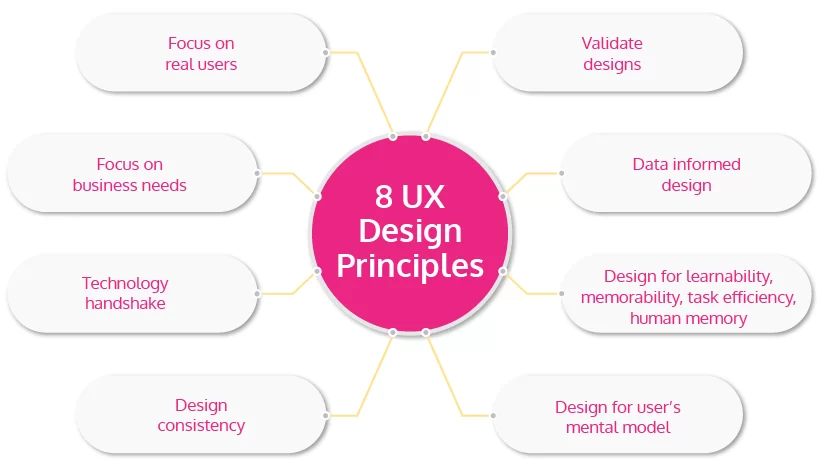At the heart of the empathy-driven design lies a profound understanding of the user’s problems and challenges. By stepping into the shoes of the users, designers and developers can craft digital experiences that not only meet but exceed user expectations.
User feedback plays a pivotal role in this process, offering a window into the users’ minds and helping graphic designers to iterate and improve with precision. However, despite its significance, many in the field struggle with where to begin in implementing empathy-driven design strategies.
In this article, let’s explore the essentials of empathy-driven design and some challenges you might face while prioritizing your users’ needs.
The Essentials of Empathy-Driven Web Design
Before making your audience’s needs one of the primary driving factors of your web design change, you need to take care of the five fundamental prerequisites:
1. Tangible Understanding of Business Objectives
This understanding goes beyond mere financial goals; it encompasses the broader impact that the website is intended to have on its audience. Knowing what the business aims to achieve with its web presence is crucial in aligning design decisions with those objectives.
A design that resonates with business objectives is more likely to engage users meaningfully, leading to higher conversion rates, better user retention, and ultimately, a stronger brand presence online.
Key metrics to assess this alignment include user engagement rates, conversion rates, time spent on site, and the bounce rate. Monitoring these metrics helps in fine-tuning the design to better serve both business goals and user needs.
2. Knowledge of Web Accessibility and User Experience (UX) Principles
The knowledge of web accessibility ensures that the website is not only aesthetically pleasing but also user-friendly for all, including those with disabilities. Understanding UX principles helps in creating intuitive, navigable, and engaging websites that cater to a wide array of users.
They ensure inclusivity and usability, which are vital for reaching a broader audience and improving overall user satisfaction.
For those looking to deepen their understanding of these essential areas, “Don’t Make Me Think” by Steve Krug is a great starting point, offering fundamental insights into web usability.
Intermediate learners can benefit from “The Design of Everyday Things” by Don Norman, which provides a more nuanced understanding of design principles. For advanced readers, “About Face: The Essentials of Interaction Design” by Alan Cooper et al. offers an in-depth exploration of interaction design principles.
3. Flexible CMS Platform with a User-Centric Design
Choosing a flexible Content Management System (CMS) is integral to fostering empathy-driven design. A CMS that readily adapts to user needs is essential in rapidly implementing design changes based on user feedback. The right CMS allows for quick and effective modifications, ensuring that the website remains aligned with user expectations and preferences.
Open-source platforms like WordPress excel in this regard. Unlike more rigid, legacy systems such as Sitecore, WordPress offers a plethora of themes and plugins that enable designers and developers to quickly and efficiently tailor websites to the unique needs and preferences of their users.
This flexibility is a key factor in WordPress’s popularity, allowing for a level of customization that is both user-centric and designer-friendly.
By partnering with an experienced Sitecore to WordPress migration agency, brands can make the transition efficiently and quickly to leverage the design benefits of a more flexible, responsive CMS, allowing them to deliver an enhanced user experience while aligning the website more closely with the evolving needs and expectations of their audience.
4. User Research Workflow and Analytics
A critical component of empathy-driven design is establishing a robust user research workflow and analytics system. This process entails methodically collecting and analyzing data on user behavior, preferences, and feedback. By doing so, businesses can gain deep insights into what users truly want and need from their website.
Instead of relying on assumptions or trends, user research and analytics provide a factual basis for understanding user interactions, pain points, and preferences. This data-driven approach ensures that design changes and updates are not just aesthetically pleasing but also functionally relevant to the users.

Various ways of conducting user research | source
There are several tools available to facilitate efficient user research and analytics. For instance, Google Analytics offers comprehensive insights into user behavior on the website. User testing platforms like UsabilityHub and Hotjar allow for direct user feedback and behavior analysis.
Additionally, tools like SurveyMonkey can be used to conduct user surveys to gather direct feedback.
5. An Attitude to Continuously Learn and Iterate
This mindset involves a commitment to ongoing education and the flexibility to adapt designs based on new insights and user feedback. It’s about viewing the design process as a journey rather than a destination, where improvement and adaptation are constants.
The importance of this approach lies in the ever-evolving nature of user preferences and technological advancements. A design that is effective today may not be as impactful tomorrow.
Therefore, having an attitude of continuous learning and iteration allows designers and developers to stay ahead of trends, anticipate user needs, and make timely enhancements to the web experience.
For those eager to cultivate this mindset, there are numerous web design blogs that offer a wealth of information and inspiration. Sites like Smashing Magazine and A List Apart provide in-depth articles on the latest trends, techniques, and best practices in web design and development.
UX Design.cc offers insights specifically on user experience, a crucial aspect of empathy-driven design. Additionally, following blogs like Web Designer Depot and CSS-Tricks can help professionals stay updated with technical tips in the field.
Challenges while Designing with Empathy
Empathy-driven design, while immensely beneficial, comes with its own set of challenges that can give you undesirable results when improperly managed. Let’s take a closer look at them to find out what can be done to mitigate them:
- Balancing User Needs and Business Goals: Finding the middle ground where user needs align with business goals is often challenging. While user-centric design focuses on user experience, it must also fulfill business objectives like conversions and sales. Striking this balance requires a deep understanding of both user behavior and business metrics.
- Managing Contrasting Needs of Users: Not all users have the same preferences or needs. Catering to a diverse user base often means making compromises and prioritizing certain design aspects over others. It’s important to identify common user personas and design for the majority while acknowledging minority needs.
- Keeping all the Stakeholders on the Same Page: Involving multiple stakeholders in the design process can lead to conflicting opinions and priorities. Ensuring clear communication and establishing a shared vision is key to keeping everyone aligned with the project’s goals.
- Handling Continuous Recurring Costs: Empathy-driven design is an ongoing process that involves regular updates and iterations. This can lead to continuous costs, which need to be managed effectively without compromising on the quality of the design.
- Over-relying on Quantitative Data: While data is crucial for informed decision-making, over-reliance on quantitative data can lead to designs that lack human touch. Balancing data with qualitative insights from real user feedback is essential.
- Minimizing Bias while Making Changes: Designers and developers may have inherent biases that influence their decisions. It’s important to recognize and eliminate these biases to ensure that design changes truly reflect user needs and not personal preferences.
Wrapping Up
Empathy-driven design is a holistic approach that emphasizes understanding and addressing the actual needs of users. This article has explored the key aspects of integrating empathy into web design, highlighting the importance of being attuned to user feedback and challenges.
We discussed the prerequisites for empathy-driven design, which include understanding business objectives, knowledge of web accessibility and UX principles, the choice of a flexible CMS, the significance of user research and analytics, and the adoption of a learner’s mindset.
It is also crucial to be aware of challenges, such as balancing user needs with business goals, managing contrasting user requirements, aligning stakeholder interests, budgeting for ongoing costs, balancing quantitative data with qualitative insights, and eliminating bias in design decisions to make this process fruitful and sustainable.
By embracing this approach, designers and businesses can create more effective, user-friendly, and inclusive websites that resonate with their audience and achieve desired business outcomes.


